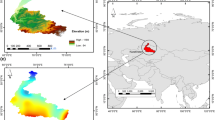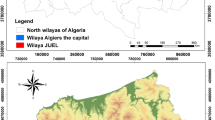Abstract
Soil loss called also soil erosion is one of the most irreversible natural phenomena that affect the topsoil of Earth’s surface worldwide, as it causes soil fertility reduction, water availability decrease, and initiation of geo-hazards, which leads to negative repercussions on agricultural production, considered the main source of income for most of the autochthonous in the moroccan High Atlas. Due to its climatic and anthropogenic conditions, this region is considered one of the most vulnerable areas to soil erosion in Morocco, with consequential environmental and socioeconomic concerns. This study assesses soil loss in the upstream part of the High Souss watershed in the moroccan western High Atlas, using an integrated analysis of Remote Sensing, GIS, and the Revised Universal Soil Loss Equation (RUSLE). This assessment is based on the integration of different influencing factors: climate, soil erodibility, topography, vegetation cover, and soil conservation practices. Results reveal that the High Souss watershed is exposed to significant erosion, with an average soil loss of 57.27 t/ha/year and an annual erosion amount of 7.3 million tons. This rate is considered to be intensively high in the moroccan context. Moreover, areas subjected to intensive erosion risk are mainly located in the upstream part of the basin, where moderate to steep slope lands are concentrated. The used methodology and results have been compounded to facilitate the analysis of this risk, providing an important basis for government decision-makers, helping the design of meaningful conservation planning programs to reduce soil erosion and conserve natural resources, thus supporting regional development.










Similar content being viewed by others
References
Alahiane N, Elmouden A, Aitlhaj A, BoutalebAlahiane S, Naima AE, Aitlhaj A, Boutaleb S (2016) Small dam reservoir siltation in the atlas mountains of central Morocco: analysis of factors impacting sediment yield. Environm Earth Sci 75(12):1–11
Arnoldus HM, JArnoldus HMJ (1977) “Methodology used to determine the maximum potential average annual soil loss due to sheet and rill erosion in Morocco.” FAO Soils Bulletins (FAO)
Bekele B, GemiBekele Y (2021) Soil erosion risk and sediment yield assessment with universal soil loss equation and GIS. In Dijo Watershed, Rift Valley Basin of Ethiopia. Model Earth Syst Environm 7(1):273–291
Bou KR (2001) “EGS_8_4_EGS_2001_8_4_BouKheir.Pdf”
Das S, Deb P, Bora PK, KatreDas P, Susanta PD, Bora PK, Katre P (2020) Comparison of RUSLE and MMF soil loss models and evaluation of catchment scale best management practices for a mountainous watershed in India. Sustainability 13(1):232
De Roo APJ, Offermans RJE, CremersDe Roo NHDT (1996) Lisem: a single-event, physically based hydrological and soil erosion model for drainage basins. Ii: sensitivity analysis, validation and application. Hydrol Process 10(8):1119–1126
Dissanayake DMSLB, Morimoto T, Manjula RanagalageDissanayake DMSLB, Morimoto T, Ranagalage M (2019) Accessing the soil erosion rate based on RUSLE Model for sustainable land use management: a case study of the Kotmale Watershed, Sri Lanka. Model Earth Syst Environm 5(1):291–306
Elaloui A et al (2017) USLE-based assessment of soil erosion by water in the watershed upstream tessaoute (Central High Atlas, Morocco). Model Earth Syst Environm 3(3):873–885
Elmouden A, Alahiane N, El Faskaoui M, El MorjaniElmouden ZEA, Alahiane AN, El Faskaoui M, El Morjani ZEA (2016) “Dams Siltation and Soil Erosion in the Souss–Massa River Basin.” In The Souss‐Massa River Basin, Morocco, Springer, 95–120
Erencin Z, Shresta DP, Krol IB (2000) “C-Factor mapping using remote sensing and GIS.” Case study Lom SakLom Kao Thail Geogr Inst Justus-Liebig-Univ Giess Intern Inst Aerosp Surv Earth SciITC Enschede Netherland
FAO (1980) “UNESCO, 1980.” Metodología provisional para la evaluación de la degradación de los suelos. Roma
FAO (2015) “Status of the World’s Soil Resources (SWSR)–Main Report.” Food and agriculture organization of the United Nations and intergovernmental technical panel on soils, Rome, Italy 650
Fayas CM et al (2019) Soil loss estimation using rusle model to prioritize erosion control in KELANI River Basin in Sri Lanka. Int Soil Water Conserv Res 7(2):130–137
Flanagan DC, Gilley JE, FrantiFlanagan TG, Dennis C, Gilley JE, Franti TG (2007) Water erosion prediction project (WEPP): development history, model capabilities, and future enhancements. Trans ASABE 50(5):1603–1612
Gourfi A, DaoudiGourfi L (2019) Effects of land use changes on soil erosion and sedimentation of dams in semi-arid regions: example of N’fis Watershed in Western High Atlas, Morocco. J Earth Sci Climatic Change 10(513):2
Issa LK, Raissouni A, Moussadek R, El ArrimIssa A, Khali L, Raissouni A, Moussadek R, El Arrim A (2014) Mapping and assessment of water erosion in the Khmiss Watershed (North Western Rif, Morocco). Curr Adv Environm Sci 2(4):119–130
Issa LK, Lech-Hab KBH, Raissouni A (2016) Cartographie quantitative Du Risque d’erosion Des Sols Par Approche SIG/USLE Au Niveau Du Bassin Versant Kalaya (Maroc Nord Occidental). J Mater Environm Sci 7(8):2778–2795
Khademalrasoul A, Amerikhah H (2021) Assessment of soil erosion patterns using RUSLE model and GIS tools (case study: The Border of Khuzestan and Chaharmahal Province, Iran). Model Earth Syst Environm 7(2):885–895
Laura RL (2010) Estimacion de La Perdida de Suelos Por Erosion HidricaEn La Cuenca Del Rio Juramento û Salta
Mateso JM, Monsieurs E, Bielders C, Dewitte O (2018) “Landslides, land use and the anthropization of a rural environment: focus on the Rift Flanks West of Lake Kivu (DR Congo)”
Meunier A (1980) “Les Mécanismes de l’altération Des Granites et Le RôleDes Microsystèmes. Etude Des Arènes Du Massif Granitique de Parthenay (Deux-Sèvres)”
Morgan RPC et al (1998) The european soil erosion model (EUROSEM): a dynamic approach for predicting sediment transport from fields and small catchments. Earth Surf Proc Land 23(6):527–544
Oldeman LR (1992) “Global extent of soil degradation.” In Bi-Annual Report 1991–1992/ISRIC, ISRIC, 19–36
Pandey A, Mathur A, Mishra SK, MalPandey BC (2009) Soil erosion modeling of a himalayan watershed using RS and GIS. Environm Earth Sci 59(2):399–410
Parysow P, Wang G, Gertner G, AndersonParysow AB, Pablo GW, Gertner G, Anderson AB (2003) Spatial uncertainty analysis for mapping soil erodibility based on joint sequential simulation. CATENA 53(1):65–78
Pérez-Rodríguez R, Marques MJ, Bienes R (2007) Spatial variability of the soil erodibility parameters and their relation with the soil map at subgroup level. Sci Total Environm 378(1–2):166–173
Ramos C (2001) “Modelamiento Ambiental Para Análisis de SusceptibilidadErosiva En La Cuenca Media y Alta Del Río Cañete y Determinación Del Mapa de Erosión.” Universidad Nacional Agraria La Molina
Renard K (1997) Predicting soil erosion by water: A guide to conservation planning with the revised universal soil loss equation (RUSLE). United States Government Printing
Roose E (1994) Introduction à La Gestion Conservatoire de l’eau, de La Biomasse et de La FertilitéDes Sols (GCES)
Seddoh FK, PedroSeddoh G, Francisco K, Pedro G (1975) Aspects Microgéochimiques de l’altération Superficielle: Application à l’étude de l’évolution Des Minéraux Dans Les Arènes Granitiques. Cahiers ORSTOM Série Pédologie 8:7–25
Sharpley AN, WilliamsSharpley JR (1990) “EPIC-Erosion/Productivity Impact Calculator: 1.” Model documentation
Shin G (1999) “The analysis of soil erosion analysis in Watershed Using GIS”
Somasiri IS, Hewawasam T, Rambukkange MP (2022) Adaptation of the Revised Universal Soil Loss Equation to Map Spatial Distribution of Soil Erosion in Tropical Watersheds: A GIS/RS-Based Study of the Upper Mahaweli River Catchment of Sri Lanka. Model Earth Syst Environm 8(2):2627–2645
Thomas RJ et al (2002) Precambrian evolution of the sirwa window, anti-atlas Orogen, Morocco. Precambrian Res 118(1–2):1–57
Velásquez S (2008) “Erosión de Suelos Utilizando La EUPSR (RUSLE).” Coronado, Costa Rica: Centro agronómico tropical de investigación y enseñanza
Wang G et al (2002) Spatial and temporal prediction and uncertainty of soil loss using the revised universal soil loss equation: a case study of the rainfall-runoff erosivity R factor. Ecol Model 153(1–2):143–155
Wischmeier WH, Smith DD (1978) Predicting rainfall erosion losses: a guide to conservation planning. Department of Agriculture, Science and Education Administration
Acknowledgements
The authors acknowledge Pr. Racha Elkadiri (Assistant professor at Middle Tennessee State University, USA), for providing technical help during the research.
Funding
This work was supported by the National Center for Scientific and Technical Research (CNRST) Rabat, Morocco [grant numbers L 006/006, 2016].
Author information
Authors and Affiliations
Corresponding author
Ethics declarations
Conflict of interest
The authors declare that they have no known competing financial interests or personal relationships that could have appeared to influence the work reported in this paper.
Additional information
Publisher's Note
Springer Nature remains neutral with regard to jurisdictional claims in published maps and institutional affiliations.
Rights and permissions
Springer Nature or its licensor holds exclusive rights to this article under a publishing agreement with the author(s) or other rightsholder(s); author self-archiving of the accepted manuscript version of this article is solely governed by the terms of such publishing agreement and applicable law.
About this article
Cite this article
Bou-imajjane, L., Belfoul, M.A., Stokes, M. et al. Adaptation of the revised universal soil loss equation (RUSLE) to soil loss modeling in a semi-arid watershed: a case study from western high atlas, Morocco. Model. Earth Syst. Environ. 8, 4775–4792 (2022). https://doi.org/10.1007/s40808-022-01476-6
Received:
Accepted:
Published:
Issue Date:
DOI: https://doi.org/10.1007/s40808-022-01476-6




